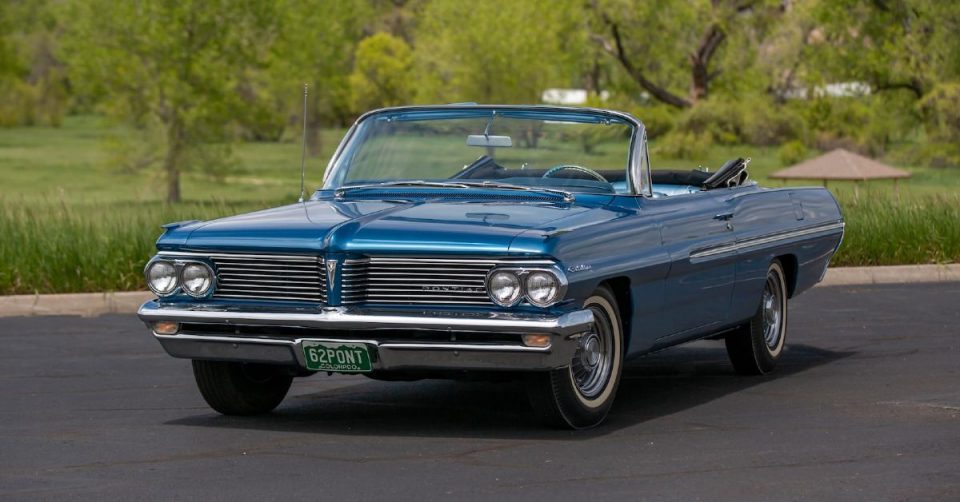Any hobbyist of the early ’60s performance scene knows quite well that the Pontiac Catalina Super Duty instilled fear into the harrowing competition. The Super Duty did not seem to mind if the challenge came on a NASCAR oval or NHRA drag strip, victorious results were almost guaranteed. Pontiac continuously distanced itself from others as a performance leader with continual engineering developments and larger displacements.
The pinnacle was the 1962 model year. Alling, an auto-parts wholesaler, owns a timepiece from that era. His ‘62 Catalina is still equipped with a 421 Super-Duty engine and has covered a mere 19,000 miles in its lifetime. While some low-mile cars have led storybook lives, this Catalina’s tale contains a few different twists and turns. The end result, however, is a stunningly original example which serves as a vestige of Pontiac’s former glory days, and still living on through the midst of 2022 Supercars.
A number of hints of the upcoming Pontiac performance revolution emerged in the late 1950s. The most famous being the mighty 389-cu in V-8, but the fact that Knudsen (a general manager of Pontiac) himself drove a Tri-Power Bonneville to an impressive 131 mph lap record at Daytona in 1957 should have been evidence that there was a true ‘car guy’ at the helm of Pontiac.
A Tri-Power option with three two-barrel carburetors became available across the Pontiac range for 1958 and raised the horsepower of the 370-cu.in. V8 to 330. Once again, Pontiac would dominate at Daytona, recording speeds as high as 137.693 mph in the flying mile.
The 1962 Pontiac Catalina Super Duty: Time To Turn It Up A Gear…

The styling stage for the high-performance was set in 1959, with the arrival of Wide Track. Knudsen decided to take the brand uptown, leaving the low end of the segment to Chevrolet, by adding 3.25 inches to the width of the body and then increasing the reach from 58 cm inch to 63-inch in the front and 59-inch to 64-inch in the rear. The 1959s saw heavier front brake drums, more accurate power steering and less dive-prone suspension.
At the same time, Knudsen was increasing Pontiac’s participation in motor sports, with a successful stock car program and a new foray into drag racing with the help of the famed Mickey Thompson. Thompson also piloted the “Challenger I,” packing four of Pontiac 389-cu.in. V-8s, to 406.6 mph in a land-speed record attempt at the Bonneville salt flats in 1960.
Pontiac’s success in stock car racing led them to branch out into drag racing in an effort to capture more of the West Coast market. It was these programs that resulted in the creation of the Super Duty packages for the Catalina. In 1961, Pontiac rolled out a lower, trimmer look and the company was yet again victorious with a podium sweep at the Daytona 500. For 1962, a new roofline was introduced.
Possibly alarmed by the success of these cars, the Hot Rod Association enforced a rule stating that cars in the Super Stock class must be actual shock cars which were sold to the public and manufactured on an assembly line in quantities of at least 50 per year.
To continue their success on the quarter-mile, Pontiac had no choice but to create a 421 Super Duty engine for drag racing and for NASCAR. There is nothing that initially distinguishes this Super Duty from any other Catalina. The only external clues to the irrational power lurking under the hood are the finned aluminum eight-lug wheels, and you have to be paying attention to spot them.
Where Can A 1962 Catalina Be Found Today?

Once you start the Super Duty Catalina, it becomes completely clear that you are in the presence of a race car. With aluminum manifolds identical to those used on the NASCAR version, a set of noisy mechanical lifters and the pistons flailing around in their bores, the 421 produces a unique sound loved by many.
Alling bought the Catalina in 2001 from Arizona, after it had received a minor refurbishing in 1985, including a coat of Mandalay Red paint. Aside from the paint and carpet, the car is otherwise original and sports only 19,000 miles. That may not sound like much, but to put it in perspective, that’s 76,000 quarter-mile runs.
What Alling owns is not a muscle car, but a race car with a license plate on it. “It was built to go out on the track and beat the competition,” he said. Over four decades after it rolled out of the factory doors, with a repaint and 19,000 miles on the odometer, the Super Duty equipped Catalina can still do just that.
The 1962 Pontiac Catalina Super Duty certainly does have a story to tell. With a history of fierce race winnings and record holding performance statistics, it will be forever known as one of the greatest drag racing machines the world has had the pleasure of knowing.
Sources: Hemmings, PontiacV8, MuscleCars, MotorTrend
Read Next
About The Author



